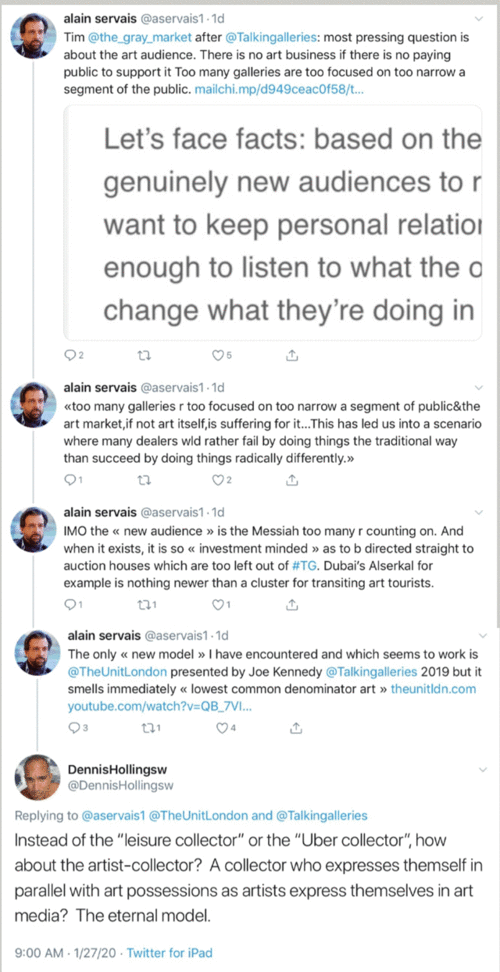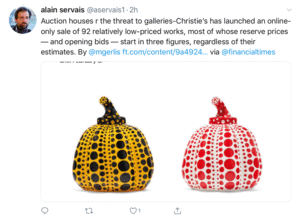January 29, 2020
Where is the love? Part Two.

(Reference: The Gray Market: Why Art Dealers Need to Focus on New Audiences or Risk Irrelevance (and Other Insights)
Consider the sobering fact that while there has always existed more artists producing art objects in the world than there are enough collectors who will collect those art objects, today the population of artists in the world has increased in logarithmic scale, exacerbating this problem. In less technical terms, compared to the NYC art world of the 40's ands 50's when you could meet nearly all of the principal actors of that time in one night of openings and after parties, today this population has grown into gargantuan proportions. In the most vulgar terms that I have read/heard elsewhere, there's more inventory than consumers that the market can bear. What repulses me about this kind of business argot is that it is usually blind to the strangely delightful ironic twist at the heart in the consideration of art as a marketplace.
What you are reading above in the tweet thread is my reply that suggests an alternative conception of the collector in opposition to the characterizations, "leisure collector" and "Uber collector", instead I propose the collector in the model of the artist. In the tweet, I coined this on the fly perhaps in a clumsy way. Alternative nominations could be collector/artist or collector-as-artist or creative collecting. I hope you understand the thrust of this idea. It's a conception of the collector as I suggest as they always have been, thinking of the Gertrude Stein or Peggy Guggenheim or Count Panza or Herb and Dorothy Vogel.
Over the past twenty years, as the population of artists grew, there has been a strange erosion of the bottom and middle art market, leaving the top end chasing a narrowing sector of elite art works. Theories abounds as to the etiology of this condition whether it was because of the growth of art fairs or auction houses or both. No one yet really knows. In this meantime, certain speculators have entered the scene who see opportunity in 1) the unregulated Wild West of the art world, 2) the opportunity of creating mutually reinforcing artificial value structures and 3) the potential of an exploding inventory of art of ambiguously good/great value languishing yet unexploited. As an example of this, check this out: KIRAC 8 'The Art of Stefan Simchowitz' (Portrait of a Los Angeles Art Dealer). The effect of all this is to drive the urge to speculate in art, to treat art as a fungible form of currency. The effect of all this is to evaporate the population of people who collect as artists make art... with love, with passionate, existential love.
Below, watch the video that Alain Servais suggested, Joe Kennedy's Unit London, presenting his idea of an art gallery that urges a shift modeled on social media. Twenty minutes in, he coins the term "Leisure Collector". ""The role of the gallery is moving into this narrative of this, sort of like an agency sort of role where marketing and storytelling becomes central." From another direction yet in the same theme, I have a dear friend, an LA gallerist, who visits NYC frequently and we enjoy time together seeing art in the city. He has been pounding me with an idea of how artists should respond to our changing world which involves artists focusing not on producing masterworks seeking a home in elite collections but rather shifting attention to elite corporations who are focusing attention to the broader public such as Google or Hollywood or even MIT. What both people like Joe Kennedy and my dear friend have in common is an anxiety and frustration with the apparent disappearance of the classical collector, the category I'm trying to encourage here as the reintegration or revival of the passionate, creative collector-as-artist. Is this a romantic notion? No doubt. But what is an artist who isn't preoccupied with creating superlative art, seeking to overcome the frontiers of their imagination and make that physical?
Check out the question from the audience at T= 29:50, identifying the core problem of the artist in the consumer centered world. "...at the end, the artists are going to do what people like..." If you think that this isn't a problem, check out this video by Anna's Analysis, The Reality of Van Life on Social Media. "We've all heard that social media isn't real life, and everyone knows that van life isn't as glamorous as it is made out to be in Instagram..." Think about the possible parallels to the art world as you watch it.
UPDATE:
1. Gagosian is creating online viewing platforms.POSTSCRIPT:
2. Servais kindly alerts us about Christies upcoming online sales platform. He suggests that this move from the auction houses will threaten the market at the gallery primary market level. Would the purchase of a low four figure art Kusama supplant the purchase of an emerging artist or a lesser known/appreciated yet talented artist at a small or midsized gallery? Are the art markets, zero sum? An interesting question...
Another thought along these lines: Consider the axiom that art is valued in terms of prestige. Alongside that, another axiom that while pricelessness is subjective and personal yet ultimately fictional, it is instrumental in establishing the structure of pricing in the art marketplace. The less willing one is to part with the possession of something (a feeling either perceived or real, interestingly), the more value it can have in a market. Does it follow inevitably from these axioms, that artists will always be subjected to the lure of upmarket galleries who have marshaled a community of higher prestige? A kind of capillary action? Does this impulsive matriculation of artists contribute to "the rich getting richer" in our art world? Elsewhere, I have suggested the organic health food world as a context to compare and model from: slow versus fast food, shorter supply chains, "natural" versus synthetic ingredients, free range versus caged..."You are what you eat" becomes "You're only as authentic as what you collect". Of course, not to veer onto another topic, but to move in the directions that I'm suggesting in this blogpost, the art world would have to rethink accepted Pomo dogma that authenticity is dead and defunct, that it is a good and desirable quality again. Until that time, the erosion could continue unabated, unchecked.
Good luck with that.
Rereading Tim Schneider's headline:
The Gray Market: Why Art Dealers Need to Focus on New Audiences or Risk Irrelevance (and Other Insights)I would rather prefer this conceptual shift:
The nurture and growth (in gardening terms) of collectors (and the audience as the seed bed for future collectors, proto-collectors) who use their collections as a mode of expression in parallel with artists who use media as their mode of expression.
Clumsy, yes. But the payload is there and hopefully on target.
Posted by Dennis at January 29, 2020 8:05 AM
Leave a comment